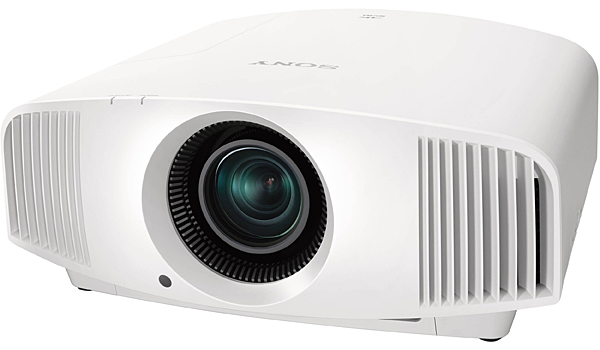Sony VPL-VW325ES 4K LCOS Projector Review

AT A GLANCE
Plus
Excellent detail
Vivid color reproduction
Motorized focus, zoom, lens shift
Minus
Relatively limited light output
No dynamic iris
Basic HDR tone-mapping adjustment
THE VERDICT
Sony's entry-level full 4K projector delivers detailed, seamless images and is a great option for dedicated home movie theaters.
Sony's projector lineup is notable for its use of the company's full 4K-resolution (4,096 x 2,160-pixel) SXRD (Sony-speak for LCOS) chips. It's also been notable for featuring a 5K model—5K as in $5,000, the price for the line's entry-level projector. Back in 2021, the company replaced that model, the VPL-VW295ES, with the VPL-VW325ES, an updated version offering a few new features, though at a higher $5,499 price. Are the updates worth the extra coin? Let's find out.
The new VW325ES's 1,500 ANSI lumens light output matches that of its predecessor. This is probably the main thing that will cause potential buyers to hesitate since it's a fairly low spec, and one that will necessitate installation in a light-controlled room. The VW325ES also has the same input lag reduction mode for gaming, 2.06x powered zoom lens, and +85 percent, -80 percent horizontal and +/-31 percent vertical powered lens shift capability. Those last two features provide highly flexible setup options, while the projector's front-facing fan allows for positioning on a high shelf on the back wall of a room.
Also carried over from the VW295ES is anamorphic lens compatibility—the only workable way to use the VW325ES in a constant-height configuration with a 2.35:1 projection screen since, like its predecessor, Sony's new projector lacks lens memories to store zoom settings. Another omission the VW325ES shares with previous entry-level 4K models is a dynamic iris to heighten contrast. While this might strike some as a limitation on paper, the native contrast ratio provided by the VW325ES's trio of SXRD imaging chips (one each for red, green, and blue) allows it to deliver satisfying black levels in action—something I'll address in detail in the Performance section of this review.

What's new in the VW325ES is the company's X1 for projector picture processor. This is a version of the same processor used in the company's flat-panel LCD and OLED TVs, but one specifically adapted for projectors. There are two key features Sony cites for X1 for projector. The first is Dynamic HDR Enhancer, which "analyzes each scene to deliver the best contrast performance when viewing HDR content, making the bright scenes brighter and the dark scenes darker," according to the company. The second is Super Resolution Reality Creation, a technology that "analyzes each scene to enrich 4K content and real-world detail and texture."
Beyond all that, the VW325ES Sony sent me to test features a handsome black case (white is another option) with a curved top surface. At 19.5 x 8 x 18.25 inches (WxHxD), it's fairly sizeable, though not visually overpowering. Video connections include a pair of HDMI 2.0b (18Gbps) inputs, and there's also a range of control connection options for more advanced installations. The VW325ES's high-pressure mercury lamp is rated for 6,000 hours in Low lamp mode.
Sony's remote control doesn't deviate from the ones packaged with its projectors and TVs for these many years. (A related side-note: The company finally has a new, considerably more streamlined and compact remote control design that will be provided with its higher-end TVs for 2022.) Most important, it has a fully backlit keypad. Direct access buttons are provided for the projector's nine picture preset options, and there are dedicated buttons for its Contrast Enhancer and Reality Creation menus, plus rocker adjustments for brightness, contrast, and sharpness.
Setup
I installed the VW325ES in my usual front projector spot: on a high shelf located at a 14-foot distance from a 92-inch diagonal, 1.1 gain Stewart Filmscreen Cima screen. The projector's motorized zoom and vertical/horizontal lens shift adjustments let me easily adjust image size and position to fill the screen from that distance, while the motorized focus allowed me to make that adjustment with my eyeballs close-up to the screen's surface.

Of the projector's nine picture presets, Cinema Film 2 mode provided the most accurate out-of-box color and gamma. I used this one in its default settings for casual viewing for several weeks before calibrating the projector, and was perfectly happy with the image quality. Consequently, calibrating the VW325ES was a simple matter, with only slight adjustments needed to the D65 Color Temperature preset, and none at all to the Color Correction (color management system) submenu with BT.709 color space enabled. For most of my viewing, I had Lamp Control set to High and the Contrast Enhancer in the Cinema Black Pro submenu set to Medium. Gamma correction was set to 2.4.
Sony's Motionflow processing can be set to Off, High, Low, or a True Cinema mode that displays movie images at their original 24 frames-per-second rate. I left the latter on for all of my viewing. A Reality Creation menu provides a wide range of control for detail enhancement and noise reduction. I played around fairly extensively with the Resolution and Noise Filtering adjustments, ultimately finding levels that struck a good balance which made images look crisp, noise-free, and natural.





























































